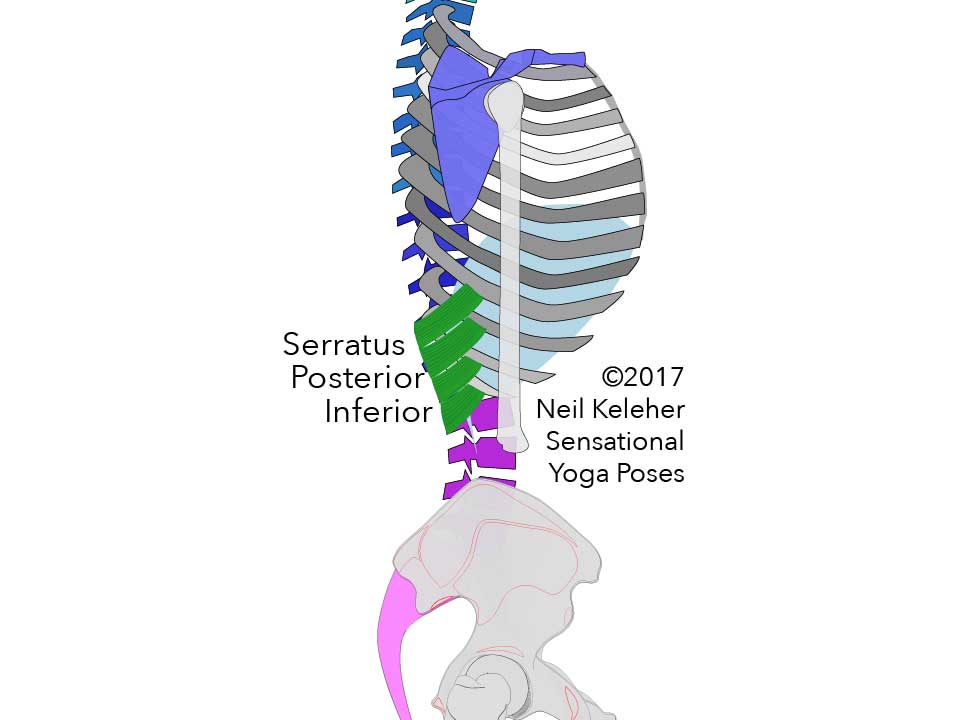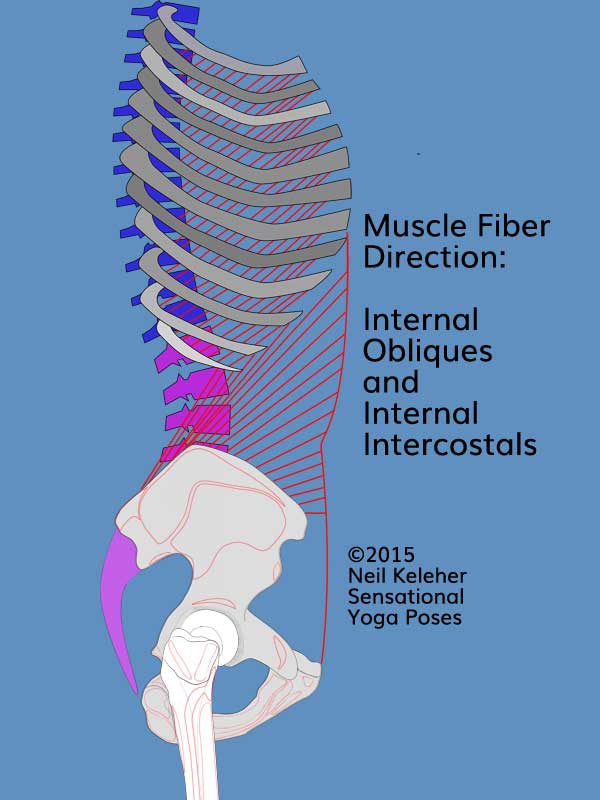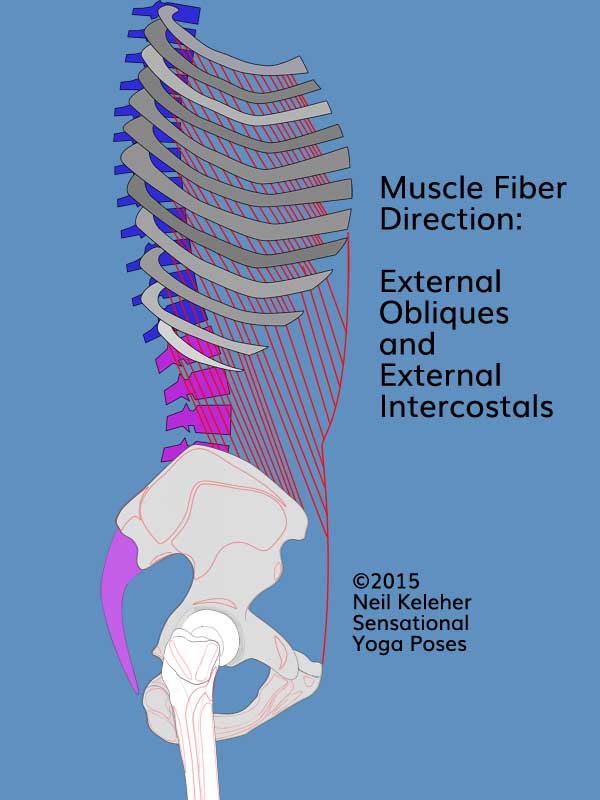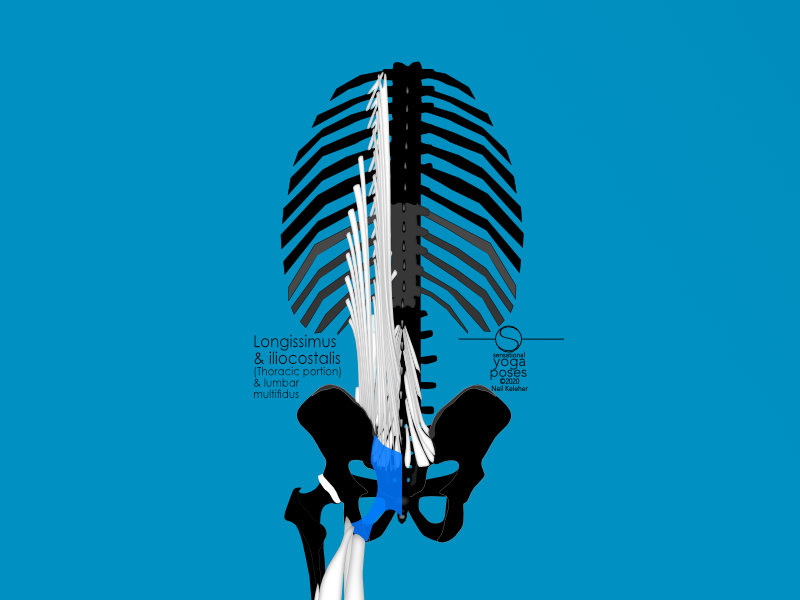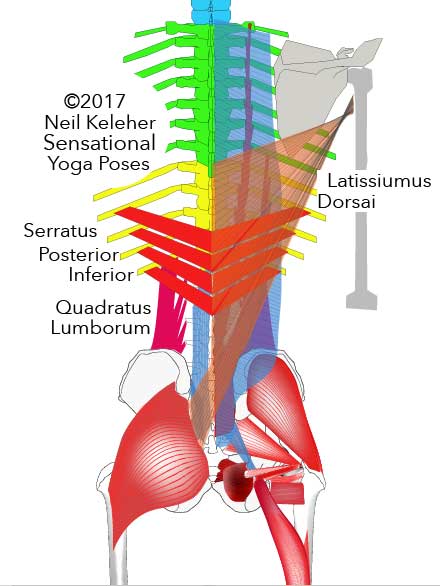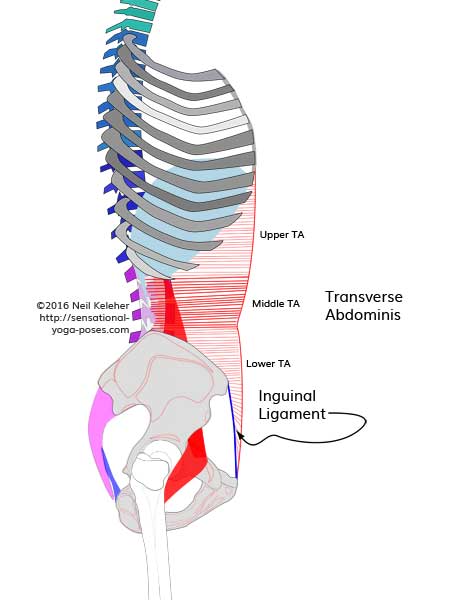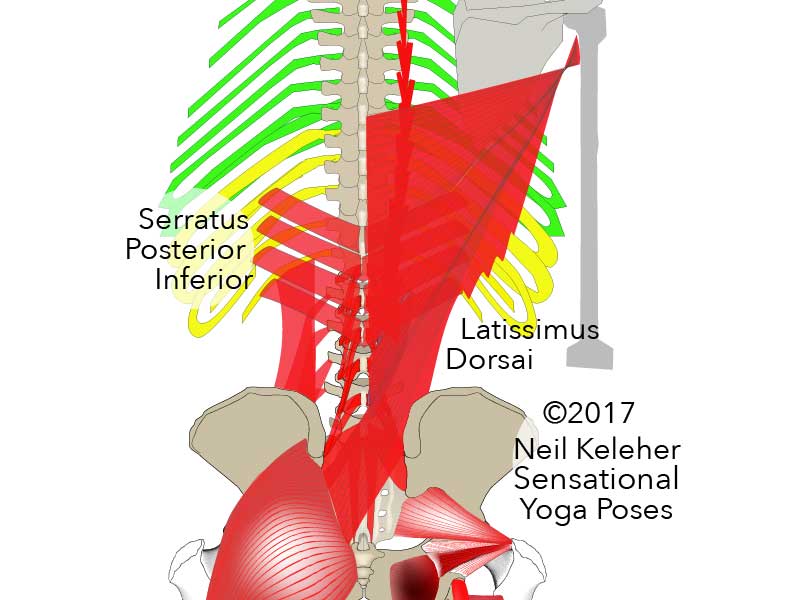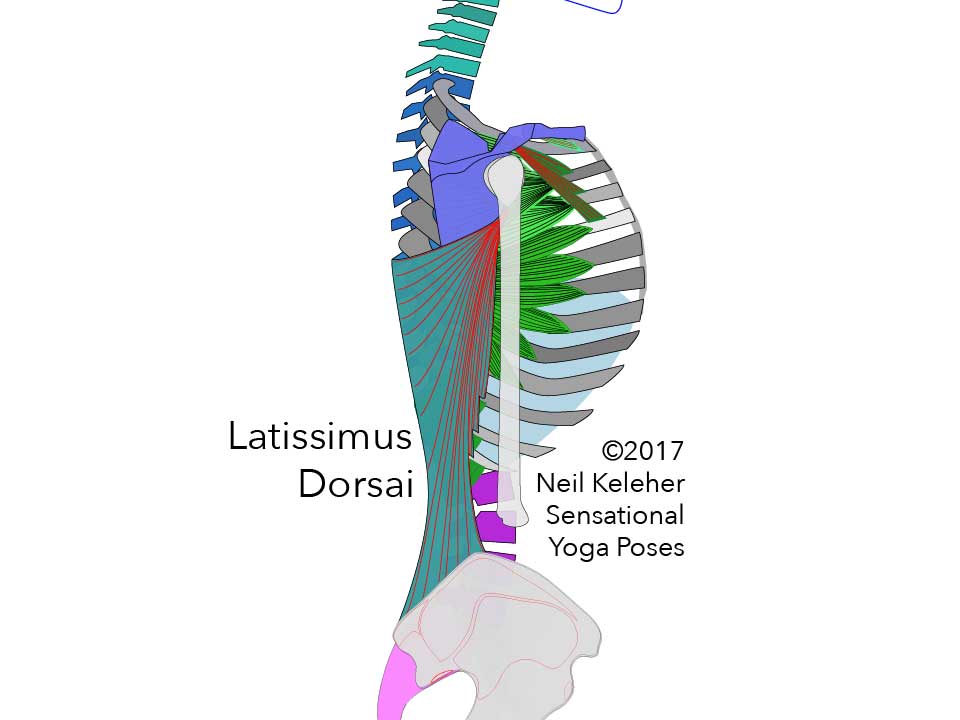Ribcage, toc
Use the links below to navigate to relavant sections on this page.
Scroll sideways in the list below for direct links to articles related to the ribcage.
for Ribcage Mobility and Control
Learn to feel them and control them
Shaping and Controlling Your Ribcage and Your Waist
The importance of the abs, intercostals, spinal erectors and more
with Simple Spinal Bending and Twisting Exercises
Anchoring the Lats and a Co-Stabilizer for the Lower Ribcage
A Tension Control Mechanism for your Abs
Improve back rib awareness, mobility and control
Using it to help position your shoulder blades relative to your ribcage
Anatomy for Yoga Teachers
Anchoring the front of the shoulder blade against upward pulling
Understanding it, stretching it, feeling it and using it.
A proprioceptive reference for better hip awareness and control
We humans have a ribcage that includes a sternum. If you look at the skeleton of a snake, it has ribs but no sternum. Look at the skeleton of an ostrich or emu; it has ribs and a very large and overly developed chest plate or sternum. Why the difference?
A snakes body is designed to undulate. Plus it doesn't have limbs. For both of there reasons snakes don't have a sternum.
With ostriches and emus, the overly developed sternum makes their ribcage stiffer and that gives the muscles that operate their wings a stable foundation from which to work.
Because a snake doesn't have limbs, it doesn't require the same ribcage stiffness that a bird does. The snake is basically one long ribcage. It' is a very long ribcage that is both flexible and strong.
In contrast, there's a particular type of turtle that has been studied. It's been proposed that the reason this particular turtle has a shell is not for defense, but to enable it to dig more powerfully with its forelimbs.
The shell serves as an anchor and foundation for its forelimbs so that the turtle can dig more effectively.
The takeaway is that for creatures with limbs, the stiffer or stronger the foundation for the muscles that work on those limbs, the more force that can be exerted via those limbs.
For creatures without limbs, like snakes, strength can be applied in a flexible manner via highly mobile ribs.
For humans, we have a ribcage that can be divided into an upper half and a lower half. The upper half is the part where the ribs attach directly to the sternum. The lower half is the part where the ribs attach to the sternum indirectly via cartilage or not at all. Thus the upper ribcage consists of the 7 true ribs while the lower ribcage is made up of the three false ribs and the two floating ribs.
Further to this, each of our arms attaches to a shoulder blade which in turn attaches to a collar bone. The collar bones attach to the top of our sternum.
An interesting point is that the bottom of the shoulder blades tends to lie even with the bottom of the sternum. This will shift as the shoulder blade moves relative to the ribcage; still it means that the shoulder blades (and better yet, the sternum) can be used as a reference for helping to differentiate the upper and lower ribcage
Based on what was said earlier, the reason we have a sternum is to make the upper part of our ribcage stiffer, giving our arm muscles a more stable foundation from which to work.
Since our lower ribs don't attach to the sternum, the lower part of our ribcage tends to be more flexible and less stable than the upper part of the ribcage.
Arm and shoulder muscles that attach to either the upper or lower part of the ribcage
Arm muscles (and this is a broad use of the term arm muscles) that attach to the upper ribs, sternum include the pectoralis major, the pectoralis minor and the upper and middle fibers of the serratus anterior. Arm muscles that attach to the lower ribs include the lower fibers of the serratus anterior and the latissimus dorsai.
While both the upper half and the lower half of the ribcage have some flexibility, the lower half is more flexible and the upper half more stable. Part of the reason for the lower ribcage being more mobile may be to enable different breathing methods. Another reason is to give our spine greater flexibility which in turn can lead to greater flexibility for our arms also.
The notion we can get from this is that to enable ourselves to use our arms with greater force we can stabilize both the upper and lower ribcage. So that we can apply force via our arms through a greater range of possible positions, we can stabilize the lower and upper ribcage in a variety of positions.
The idea then is to learn to use the muscles of our spine and ribcage so that we can shape our ribcage but also so that we can stabilize it.
If you look at any camera tripod, they generally have the option of undoing a lever so that you can turn the camera in any direction. Then you can lock it once you have your subject is suitably framed.
With the ribcage and shoulders, we have the same options (if we choose to work at it.)
We can shape the ribcage appropriately to how we want to use our arms. Then, if we need to use our arms powerfully, we can then stabilize the ribcage so that our arms have a stable foundation from which to work. The point here is that stability isn't due to positioning but rather due to the action of muscles working against each other to create a stabilizing effect.
Note, depending on how much power we wish to exert and in what direction, we may also need to stabilize the neck and/or waist.
Focusing on the ribcage though, what can we do to make it more stable so that we can use our arms with less effort? In addition, what can we do to increase ribcage (and thoracic) mobility so that we can apply arm strength in various directions?
Both mobility and stability can achieved via muscle control. We can use muscles against each other (or against an opposing force) to vary the shape of the ribcage. We can also use muscles against each other to stabilize the ribcage.
The intercostal muscles are muscles that connect and work on adjacent ribs. Meanwhile, the obliques attach, mainly, between the hip bones and the lower ribs.
One idea is to use the internal and external intercostal muscles against each other. And indeed that can be useful for both shaping the ribcage and maintaining that shape despite external forces acting on it.
These pictures could have been labelled a little better.
The intercostals are the muscles between the ribs.
The obliques are positioned between the ribcage and the pelvis.
Another set of muscles that can be used to mobilize and stabilize the ribcage along with the intercostals and obliques are the spinal erectors. In particular the iliocostalis and the longissimus, both of which attach to the ribs, can also be used to help stiffen the ribcage.
These muscles can work against the obliques and intercostals to create ribcage stability.
The iliocostalis attach from the hip bones to the ribs while the longissimus attach from the sacrum to the ribs. And so a good tip when trying to activate these muscles is to stabilize your hip bones and sacrum (as well as the si joints!)
One way to get a feel for your ribcage is to practice mobilizing it as in these ribcage mobility exercises.
The better you get at feeling the muscles you are using to mobilize your ribcage the easier it is to control them and then also use them to stabilize your ribcage. For more on this, also check out thoracic mobility
Another idea focuses specifically on the lower ribcage.
This is the part that corresponds to the arch of the ribcage (the arch that houses the upper abdominal muscles.)
This part of the ribcage has the lower 5 ribs, the top 3 of which are false ribs, the bottom two of which are "floating" ribs. It also has the lower 5 thoracic vertebrae. These are the ribs that lack a direct connection to the sternum and so this part of the ribcage tends to be more flexible and thus requires more effort to make stable.
So what muscles can we use to stabilize this part of the ribcage (or at least a portion of it).
The Serratus Posterior Inferior muscle attaches to backs of the lower four ribs. From these ribs, the fibers (or fascicles) of this muscle angle downwards and inwards to attach to the lower two thoracic vertebrae and the upper two lumbar vertebrae.
The upper band of the Transverse Abdominis attaches to the front of these same ribs.
My own experience has shown that these two sets of muscles can work against each other to help stabilize the lower ribcage.
Note that because the serratus posterior inferior create a downwards pull on the backs of the lower ribs, it can help to first lift the ribs to give the fibers of this muscle room to contract and to give these fibers an opposing force to work against.
Another way to think of this is giving these muscles optimal length so that they can activate more effectively.
- A basic principle in muscle control is that muscles need an opposing force to work against.
If they have no opposing force, then they won't turn on. That opposing force can come from opposing muscles.
- Another principle is that muscles have a range in which they function best, or optimal length range, and so for better muscle control we can lengthen and shorten muscles as required.
In some cases we can use other muscles to help lengthen a target muscle optimally.
- One other (but not the only other) basic principle is that or anchor point for effective control.
An upwards lift of the ribs may be created by use of the external intercostals (which attach between adjacent ribs) in addition to the levator costarum muscles (which reach downwards from thoracic vertebrae to attach to ribs one or two levels below).
One tip then for activating the serratus posterior inferior muscle fibers is to first lift the backs of the lower ribs and then create a downwards (and inwards) pull on these ribs, pulling them towards the upper lumbar spine.
So which "arm" muscles will stabilizing the lower ribcage affect the most?
Arm and shoulder muscles that have fibers that attach to the lower ribs include the serratus anterior and the latissimus dorsai.
The latissimus dorsai is generally though of as a pulling muscle while
the serratus anterior tends to be involved in pushing actions.
And so stabilizing the lower ribcage may be useful in both pushing actions (which generally require the serratus anterior) and pulling actions (which require the latissimus dorsai).
In the left picture you can see how some fibers of the latissimus dorsai attach to the lower three ribs.
In the right picture you can also see the serratus anterior muscle (unlabeled) in green.
(You can also see pectoralis minor, just above it!)
If you are into gym work, one way you can test this out, assuming you've got the ability to turn on your upper transverse abdominis and serratus posterior inferior muscles at will, is to try those muscle activations doing a bench press and while doing lat pull downs or chin ups or pull ups.
- If you are doing pull ups, or some other type of exercise that requires the lats, (climbing up a rope) creating a downward pull on the backs of the lower ribs may help you to use more fibers of the latissimus dorsai (in particular the fibers that attach to the lower three ribs) making it easier to do that exercise.
- Is you are doing bench press, then pulling the inwards (towards each other) on the ribs at either side of the costal arch may help you to utilize the lower fibers of the serratus anterior making bench pressing easier.
In either case, whether you focus on activation the serratus posterior inferior or the upper transverse abdominis, the opposing muscles will also tend to activate (since, as mentioned, muscles need an opposing force to act against.)
Even though the lower ribs don't attach directly to the sternum, the lower ribs are still closely tied to the upper ribs. Movement of the lower ribs tends to affect the upper ribs and vice versa.
In the picture above, you can see another muscle that ties in to "arm strength", the pectoralis minor. It attaches from the coracoid process of the scapula and from there reaches down to attach to the fronts of the upper ribs. To anchor it, you may find it helps to create a downward pull on the fronts of the lower ribs. This then helps to anchor the fronts of the upper ribs also, which then anchors the pectoralis minor. If you are hanging from the arms with the arms overhead, this is one way of helping to anchor the scapula.
Note that since the upper fibers of the psoas muscle attaches to the uppermost lumbar vertebrae, then stabilizing this region of the ribcage and the upper lumbar spine can help to give the psoas an anchor point for more effective functioning.
Thus if you think of the psoas as a possible factor in lower back pain then being able to stablize the lower ribcage and junction of the thoracic spine and lumbar spine via the upper transverse abdominis and serratus posterior inferior muscles may help.
Note that psoas interaction is a two way street. While stabilizing the lower ribcage can be used to give the upper fibers of the psoas a fixed anchor point, psoas activation can also increase lower ribcage stability.
This again may be useful in pulling actions with the arms overhead.
Note that to get a taste of how to activate the psoas, look at better hip control via the hip crease.
To activate the psoas for overhead pulling actions, experiment with closing your hip crease.
As well as acting as a potential anchor for the arms, the ribcage (and spine) could be used to help anchor the legs. One possible route is via the psoas. Another potential route is via the obliques which attach from the ribs to the hip bones. These muscles could help anchor the hip bones from a stable ribcage and that in turn can affect the knees.
Read more about this in Knees, spine, ribcage and mood.
Published: 2019 04 03
Updated: 2020 10 28
